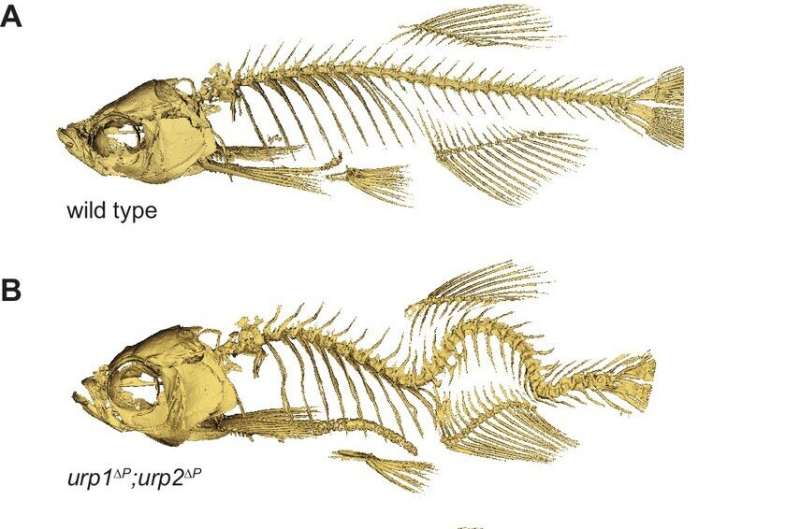Urp1 and Urp2 are required for proper adult spine morphology. (A–C) Lateral views of microcomputed tomography reconstitutions of wild-type (A), urp1∆P;urp2∆P (B) and uts2r3b1436 (C) mutants at 3 mpf. (D) Cobb angle measurements for individual fish in the sagittal plane for urp1∆P;urp2∆P and uts2r3b1436 mutants. Circles represent angles for individual curves. (E-E’) Total Cobb angles with each circle representing an individual fish. The mean ± s.d. is shown. (G’) is the data from G parsed for sex. p-Values are given from two-tailed unpaired student’s t tests. (F) The position of curve apex is plotted and shows that most curves are in caudal vertebrae. n=9 and 8 for urp1∆P;urp2∆P and uts2r3b1436 mutants, respectively. Credit: eLife (2022). DOI: 10.7554/eLife.83883
University of Oregon scientists have uncovered new clues to the genetic basis for scoliosis, an abnormal curvature of the spine.
Researchers in the lab of UO biology professor Dan Grimes have identified two tiny proteins that help keep the spine straight during key periods in development. Zebrafish with mutations in these proteins end up with curved spines, mimicking what's seen in people with scoliosis.
The team reported their findings Dec. 1 in the journal eLife. Grimes' lab is part of the Department of Biology in the UO's College of Arts and Sciences.
Idiopathic scoliosis, the kind that isn't the result of an underlying condition like muscular dystrophy or cerebral palsy, typically shows up in teens, often during a big growth spurt. But there's still a lot that researchers don't understand about scoliosis.
Humans' bipedal posture puts pressure on the spine in a way that isn't replicated by four-legged lab animals like mice and rats, so it's been hard to study spinal curvature in the lab.
But as a postdoctoral researcher, Grimes spotted zebrafish with curved spines resulting from genetic mutations. The fish's forward movement through the water might more closely mimic the forces acting on the human spine, Grimes thought.
Digging into it further, he found that waving cilia, tiny hairs lining the spine, push cerebrospinal fluid along. The fluid movement through the spine was essential for keeping it straight. Fish with mutations that disrupted the cilia, and thus the fluid movement, ended up with curved spines.
This new study reveals the next step along the path. Zebrafish with mutations in two specific proteins end up with a curved spine, mimicking what's seen in people with scoliosis, the team showed.
The two small proteins are made by neurons in the spine. Their production is activated by the moving spinal fluid, and therefore by cilia. Once released by the neurons, these proteins then latch onto receptors in the muscles surrounding the spine, the researchers suspect, perhaps affecting how those muscles support the spine.
The proteins seem to be particularly crucial at certain points in development. In some of their experiments, the researchers used fish that were temperature sensitive. By changing the water temperature of the tank, they could turn certain genes on or off at different times.
"If we mess with them during adolescence, we see big spine curves," Grimes said. "That shows the pathway is really operational during these growth stages, just as we see in humans, when scoliosis typically onsets in teenagers."
Next, the team plans to study what happens further along this pathway, with the hopes of better understanding the root causes of scoliosis.
"It's kind of a mystery how the protein itself makes it to the receptor," said graduate student Zoe Irons, so that's a question for further exploration.
And the findings can inform scientists' broader understanding of animal form and function, too.
"One of the main interests in my lab is to understand how small molecular processes give rise to big anatomical shapes," Grimes said. "This is a good model for that, because it's neurons, muscle, bone all coordinating together."
More information: Elizabeth A Bearce et al, Urotensin II-related peptides, Urp1 and Urp2, control zebrafish spine morphology, eLife (2022). DOI: 10.7554/eLife.83883
Journal information: eLife
Provided by University of Oregon
























